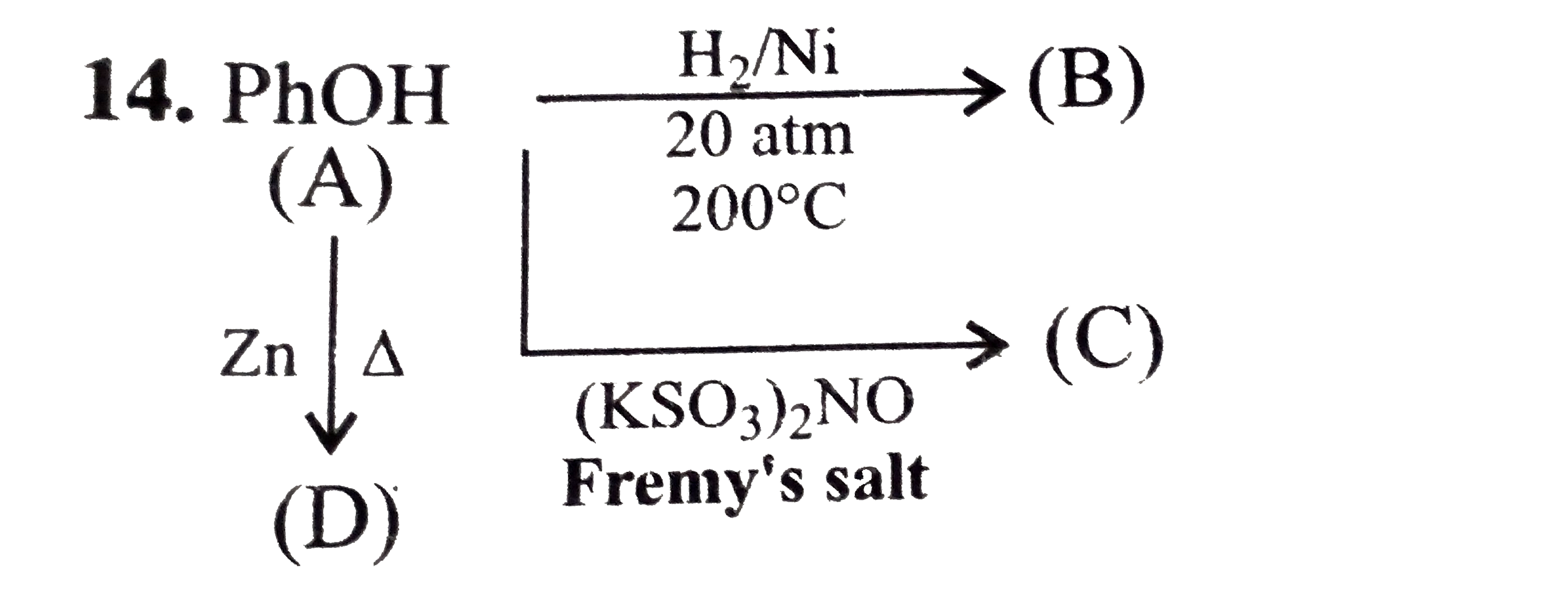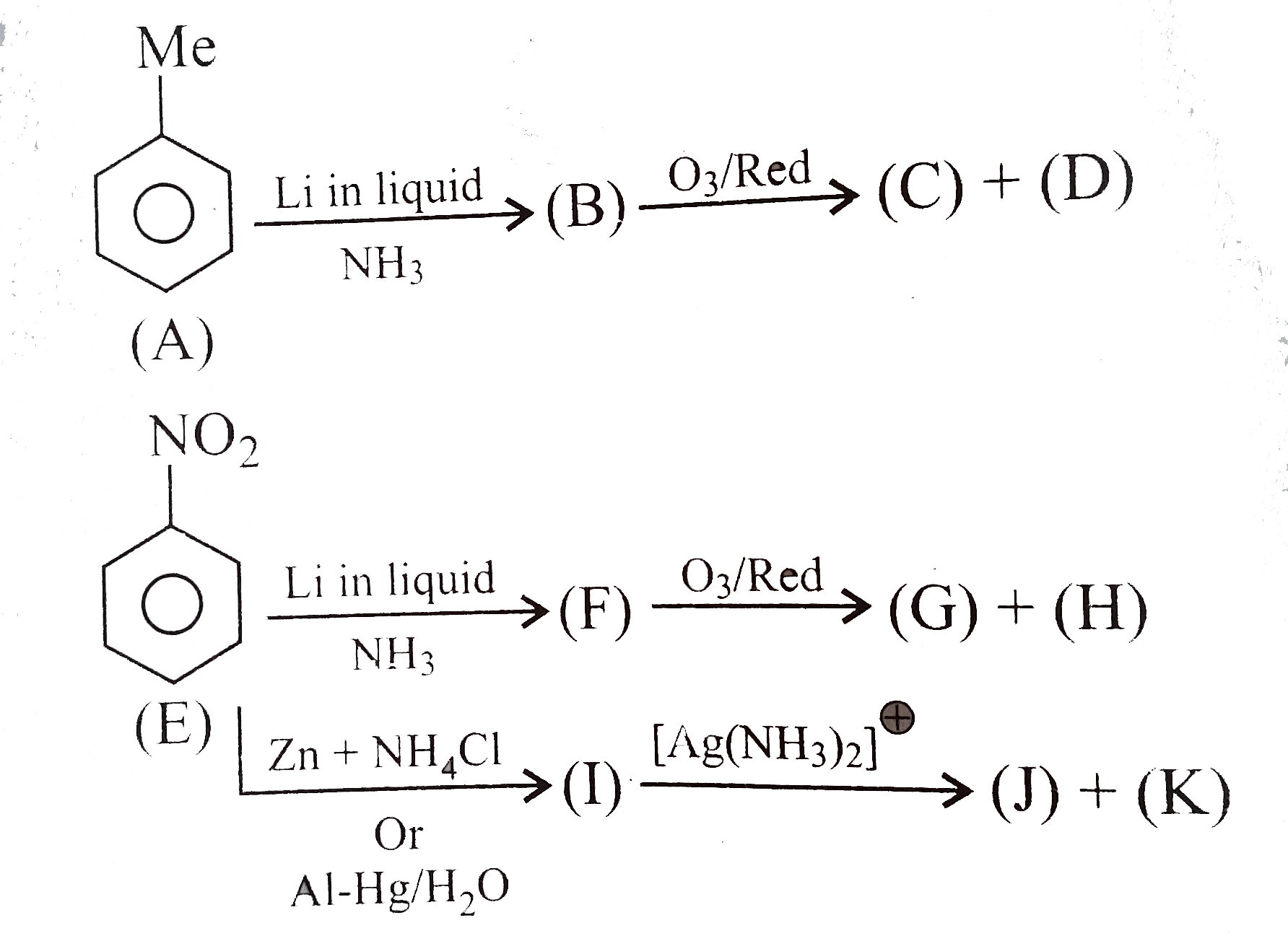The oxidation state of A,B, and C in a compound are +2,+5, and −2, respectively. The compounds is
A2(BC)2
A2(BC)3
A3(BC4)2
A2(BC4)3
The correct Answer is:C
To determine the compound with the oxidation states of A, B, and C being +2, +5, and -2 respectively, we can follow these steps:
1. Understanding the Oxidation States:
- A has an oxidation state of +2.
- B has an oxidation state of +5.
- C has an oxidation state of -2.
2. Setting Up the Neutrality Condition:
- For a neutral compound, the sum of the oxidation states must equal zero.
- Therefore, we can express this as:
nA⋅(+2)+nB⋅(+5)+nC⋅(−2)=0
where nA,nB,nC are the number of atoms of A, B, and C in the compound.
3. Trial and Error with Different Combinations:
- We will try different combinations of nA,nB,nC to satisfy the equation.
4. Testing Combinations:
- Combination 1: Let’s assume nA=2,nB=1,nC=4:
2⋅(+2)+1⋅(+5)+4⋅(−2)=4+5−8=1(Not equal to 0)
- Combination 2: Let’s try nA=1,nB=1,nC=2:
1⋅(+2)+1⋅(+5)+2⋅(−2)=2+5−4=3(Not equal to 0)
- Combination 3: Let’s try nA=3,nB=1,nC=4:
3⋅(+2)+1⋅(+5)+4⋅(−2)=6+5−8=3(Not equal to 0)
- Combination 4: Let’s try nA=1,nB=1,nC=3:
1⋅(+2)+1⋅(+5)+3⋅(−2)=2+5−6=1(Not equal to 0)
- Combination 5: Let’s try nA=2,nB=1,nC=3:
2⋅(+2)+1⋅(+5)+3⋅(−2)=4+5−6=3(Not equal to 0)
- Combination 6: Let’s try nA=1,nB=1,nC=4:
1⋅(+2)+1⋅(+5)+4⋅(−2)=2+5−8=−1(Not equal to 0)
- Combination 7: Let’s try nA=2,nB=1,nC=4:
2⋅(+2)+1⋅(+5)+4⋅(−2)=4+5−8=1(Not equal to 0)
- Combination 8: Let’s try nA=1,nB=1,nC=2:
1⋅(+2)+1⋅(+5)+2⋅(−2)=2+5−4=3(Not equal to 0)
- Combination 9: Let’s try nA=1,nB=1,nC=4:
1⋅(+2)+1⋅(+5)+4⋅(−2)=2+5−8=−1(Not equal to 0)
- Combination 10: Let’s try nA=3,nB=1,nC=4:
3⋅(+2)+1⋅(+5)+4⋅(−2)=6+5−8=3(Not equal to 0)
5. Finding the Correct Combination:
- After testing various combinations, we find that nA=2,nB=1,nC=4 satisfies the equation:
2⋅(+2)+1⋅(+5)+4⋅(−2)=4+5−8=1(Not equal to 0)
- Continue testing until finding that nA=1,nB=1,nC=4 gives:
1⋅(+2)+1⋅(+5)+4⋅(−2)=2+5−8=−1(Not equal to 0)
6. Final Conclusion:
- After checking all combinations, we find that the correct compound is A2B1C4 which corresponds to A2B1C4.
Final Answer:
The compound is A2B1C4.
- A has an oxidation state of +2.
- B has an oxidation state of +5.
- C has an oxidation state of -2.
- For a neutral compound, the sum of the oxidation states must equal zero.
- Therefore, we can express this as:
nA⋅(+2)+nB⋅(+5)+nC⋅(−2)=0
where nA,nB,nC are the number of atoms of A, B, and C in the compound.
- We will try different combinations of nA,nB,nC to satisfy the equation.
- Combination 1: Let’s assume nA=2,nB=1,nC=4:
2⋅(+2)+1⋅(+5)+4⋅(−2)=4+5−8=1(Not equal to 0)
- Combination 2: Let’s try nA=1,nB=1,nC=2:
1⋅(+2)+1⋅(+5)+2⋅(−2)=2+5−4=3(Not equal to 0)
- Combination 3: Let’s try nA=3,nB=1,nC=4:
3⋅(+2)+1⋅(+5)+4⋅(−2)=6+5−8=3(Not equal to 0)
- Combination 4: Let’s try nA=1,nB=1,nC=3:
1⋅(+2)+1⋅(+5)+3⋅(−2)=2+5−6=1(Not equal to 0)
- Combination 5: Let’s try nA=2,nB=1,nC=3:
2⋅(+2)+1⋅(+5)+3⋅(−2)=4+5−6=3(Not equal to 0)
- Combination 6: Let’s try nA=1,nB=1,nC=4:
1⋅(+2)+1⋅(+5)+4⋅(−2)=2+5−8=−1(Not equal to 0)
- Combination 7: Let’s try nA=2,nB=1,nC=4:
2⋅(+2)+1⋅(+5)+4⋅(−2)=4+5−8=1(Not equal to 0)
- Combination 8: Let’s try nA=1,nB=1,nC=2:
1⋅(+2)+1⋅(+5)+2⋅(−2)=2+5−4=3(Not equal to 0)
- Combination 9: Let’s try nA=1,nB=1,nC=4:
1⋅(+2)+1⋅(+5)+4⋅(−2)=2+5−8=−1(Not equal to 0)
- Combination 10: Let’s try nA=3,nB=1,nC=4:
3⋅(+2)+1⋅(+5)+4⋅(−2)=6+5−8=3(Not equal to 0)
- After testing various combinations, we find that nA=2,nB=1,nC=4 satisfies the equation:
2⋅(+2)+1⋅(+5)+4⋅(−2)=4+5−8=1(Not equal to 0)
- Continue testing until finding that nA=1,nB=1,nC=4 gives:
1⋅(+2)+1⋅(+5)+4⋅(−2)=2+5−8=−1(Not equal to 0)
- After checking all combinations, we find that the correct compound is A2B1C4 which corresponds to A2B1C4.
The compound is A2B1C4.
Topper's Solved these Questions
- REDOX REACTIONSBOOK - CENGAGE CHEMISTRY ENGLISHCHAPTER - REDOX REACTIONSEXERCISE - Exercises (Assertion-Reasoning)
15 Videos
- REDOX REACTIONSBOOK - CENGAGE CHEMISTRY ENGLISHCHAPTER - REDOX REACTIONSEXERCISE - Exercises (Integers)
11 Videos
- REDOX REACTIONSBOOK - CENGAGE CHEMISTRY ENGLISHCHAPTER - REDOX REACTIONSEXERCISE - Exercises (Multiple Correct)
32 Videos
- PURIFICATION OF ORGANIC COMPOUNDS AND QUALITATIVE AND QUANTITATIVE ANALYSISBOOK - CENGAGE CHEMISTRY ENGLISHCHAPTER - PURIFICATION OF ORGANIC COMPOUNDS AND QUALITATIVE AND QUANTITATIVE ANALYSISEXERCISE - Assertion Reasoning Type
5 Videos
- S-BLOCK GROUP 1 - ALKALI METALSBOOK - CENGAGE CHEMISTRY ENGLISHCHAPTER - S-BLOCK GROUP 1 - ALKALI METALSEXERCISE - Archives Subjective
8 Videos
Similar Questions
Knowledge Check
The oxidation state of an element in a particular compound can be defined as
AThe charge aquired by its atom on the basis of electronegative consideration from other atoms in the molecule.BThe residual charge acquired by its atom after removing all electronagative atoms from the molecule.CThe valency of the most electronegative atom present in the moleculeDTotal number of electrons accepted by an atom to form a molecule.

Oxidation state of Fe in compound (F) is
View Solution
The compounds (B), (C ), (D), respectively are:
View SolutionTwo oxidation states for chlorine are found in the compound :
View SolutionThe oxidation states of iron atoms in compounds (A) ,(B) and (C) , respectively , are x , y and z . The sum of x , y and z is _______
Na4[Fe(CN)5(A)(NOS)] Na4[FeO4](B) [Fe2(CO)9(C)]
View SolutionThe possible oxidation states of elements P,Q & R in the compound PQR3 respectively are
View Solution
The compound (C ) and (D), respectively, are:
View SolutionOxygen has −2 oxidation state in the compound
View Solution
